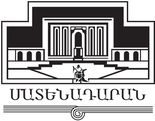CHARSANJAK GOSPEL
The manuscript was commissioned by was copied by Simeon vardapet in 1471 in Jerusalem. It was taken to Western Armenia and kept in St. Kevork church (St. George) in the village of Godarich in Charsanjak district. The manuscript is enclosed in a double silver binding, depicting the crucifixion of Christ on the front cover and

